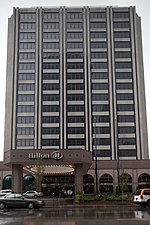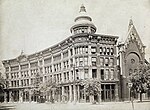Indianapolis Traction Terminal
1904 establishments in Indiana1972 disestablishments in IndianaBuildings and structures demolished in 1972Buildings and structures in IndianapolisDemolished railway stations in the United States ... and 4 more
Former railway stations in IndianaRailway stations in the United States closed in 1941Railway stations in the United States opened in 1904Transportation buildings and structures in Marion County, Indiana

The Indianapolis Traction Terminal was a major interurban train station in downtown Indianapolis, Indiana. It was the largest interurban station in the world and at its peak handled 500 trains per day and seven million passengers per year. The station opened in 1904 and remained in use until 1941, when interurban operation ended. It continued to serve as a bus station until 1968 and was demolished in 1972. The Hilton Indianapolis now stands at its location.
Excerpt from the Wikipedia article Indianapolis Traction Terminal (License: CC BY-SA 3.0, Authors, Images).Indianapolis Traction Terminal
West Market Street, Indianapolis
Geographical coordinates (GPS) Address Phone number Website Nearby Places Show on map
Geographical coordinates (GPS)
| Latitude | Longitude |
|---|---|
| N 39.768958333333 ° | E -86.160555555556 ° |
Address
Hilton Indianapolis Hotel & Suites
West Market Street 120
46204 Indianapolis
Indiana, United States
Open on Google Maps










